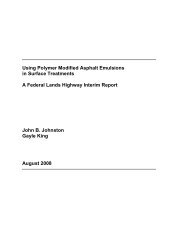Handbook for Bridge Inspections - TSP2
Handbook for Bridge Inspections - TSP2
Handbook for Bridge Inspections - TSP2
You also want an ePaper? Increase the reach of your titles
YUMPU automatically turns print PDFs into web optimized ePapers that Google loves.
5 Damage<br />
Evaluation<br />
Fundamentals<br />
5.1 General<br />
When evaluating a damage on a bridge the fo ll owing must be decided:<br />
Basis <strong>for</strong> Evaluation<br />
of Damage<br />
Types of Oa mage<br />
• Dclcnninc the Type of Damage<br />
• Detennine the Consequence of Damage to the bridge<br />
• Dctcnnine the Cause of Damage<br />
In most cases the evaluation ofa damage consists of a visual<br />
check, sometimes followed by measurements and ma.terial investigations.<br />
However, in some special cases, it may be necessary to<br />
carry out calculations of structural capacity, economical considerations<br />
and/or in vestigation by implementing long lenn instrumentati<br />
on survey on the bridge in order to establish rel iab Ie in<strong>for</strong>mation<br />
to evaluate the damage correct.<br />
Deg reel Consequence<br />
of Damage<br />
Cause of Damage<br />
In order to established a unified description of damag e, the listed<br />
types of damage in chapter 5.2 have to be used.<br />
Any damage to be recorded shall be assessed by consjdering the<br />
degree of damage and the consequence of damage.<br />
As part of a complete damage evaluation, al so the cause to the<br />
damage has to be determined. The most common causes of damage<br />
are li sted in chapter 5.6.<br />
5.2 Types of Damage<br />
The most common "Types of Damage" are listed below with a<br />
brief explanatory text connected to each of them. A more extensive<br />
and detailed description of each type of damage inelu sive examples<br />
are given in chapter 9 The Damage Evaluation Catalogue.<br />
Each type of damage is given a three-digit code where the first<br />
digit indicates the material or element the damage referred to, and<br />
the second and third indicate the type of damage. This in order to<br />
ease the registration of damage in the data base, and make it possible<br />
to scan the data/and make statistics. It should be noticed that<br />
one defect may consists of several Types o f Damage.
















